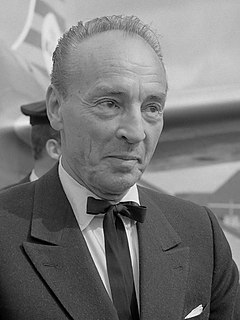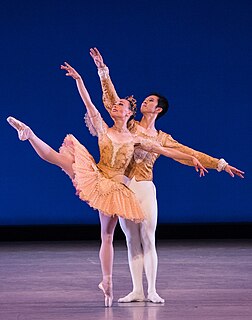Related Research Articles

George Balanchine was an American ballet choreographer who was one of the most influential 20th-century choreographers. Styled as the father of American ballet, he co-founded the New York City Ballet and remained its Artistic Director for more than 35 years. His choreography is characterized by plotless ballets with minimal costume and décor, performed to classical and neoclassical music.

New York City Ballet (NYCB) is a ballet company founded in 1948 by choreographer George Balanchine and Lincoln Kirstein. Balanchine and Jerome Robbins are considered the founding choreographers of the company. Léon Barzin was the company's first music director. City Ballet grew out of earlier troupes: the Producing Company of the School of American Ballet, 1934; the American Ballet, 1935, and Ballet Caravan, 1936, which merged into American Ballet Caravan, 1941; and directly from the Ballet Society, 1946.
Ib Andersen is a Danish ballet dancer, choreographer, and painter. Admired as both a dancer and a choreographer, he is an artist who is comfortable engaging with both the classical and contemporary aesthetic of modern-day ballet.
Jewels is a three-act ballet created for the New York City Ballet by co-founder and founding choreographer George Balanchine. It premièred on Thursday, 13 April 1967 at the New York State Theater, with sets designed by Peter Harvey and lighting by Ronald Bates.

Nicholas Magallanes was a principal dancer and charter member of the New York City Ballet. Along with Francisco Moncion, Maria Tallchief, and Tanaquil Le Clercq, Magallanes was among the core group of dancers with which George Balanchine and Lincoln Kirstein formed Ballet Society, the immediate predecessor of the New York City Ballet.

Theme and Variations is a ballet choreographed by George Balanchine to the final movement of Tchaikovsky's Orchestral Suite No. 3. The ballet was made for Ballet Theatre, and premiered on November 26, 1947, at the City Center 55 Street Theater, with the two leads danced by Alicia Alonso and Igor Youskevitch.
Tarantella is a ballet choreographed by George Balanchine to Grande Tarantelle by Louis Moreau Gottschalk, arranged by Hershy Kay. The ballet premiered on January 7, 1964, at the New York City Center, performed by New York City Ballet's Patricia McBride and Edward Villella.
Symphony in C, originally titled Le Palais de Cristal, is a ballet choreographed by George Balanchine, to Georges Bizet's Symphony in C. The ballet was originally created for the Paris Opera Ballet, and premiered on July 28, 1947 at Théâtre National de l'Opéra.
Circus Polka: For a Young Elephant was written by Igor Stravinsky in 1942. He composed it for a ballet production that the choreographer George Balanchine did for Ringling Bros. and Barnum & Bailey Circus. The ballet was performed by fifty elephants and fifty ballerinas. In 1944, Stravinsky published an orchestration of the piece, which is now part of the repertoire of many orchestras.
Prodigal Son, or Le Fils prodigue, Op. 46 is a ballet created for Diaghilev's Ballets Russes by George Balanchine to music by Sergei Prokofiev (1928–29). The libretto, based on the parable in the Gospel of Luke, was by Boris Kochno, who added a good deal of drama and emphasized the theme of sin and redemption ending with the Prodigal Son's return.
Élégie is a neoclassical ballet by George Balanchine, to Élégie-Elegy for solo viola by Igor Stravinsky. Balanchine had made three versions of the ballet, premiered in 1948, 1966 and 1982 respectively.
Kay Mazzo is an American former ballet dancer and educator. In 1961, she joined Jerome Robbins' company, Ballets USA. The following year, she joined the New York City Ballet, and was promoted to principal dancer in 1969. She created roles for George Balanchine and Robbins, before retiring from performing in 1981. She then joined the permanent faculty of the School of American Ballet in 1983, named Co-Chairman of Faculty in 1997 and Chairman of Faculty in 2018.
Monumentum pro Gesualdo is a ballet by the New York City Ballet (NYCB) co-founder and balletmaster George Balanchine to music by Igor Stravinsky composed in honor of the 400th birthday of the composer Carlo Gesualdo and consisting of Stravinsky's orchestrations of Gesualdo's madrigals. The premiere took place on Wednesday, November 16, 1960, at City Center of Music and Drama, New York, with scenery and lighting by David Hays and was conducted by Robert Irving. The composer conducted the score's orchestral premiere on Tuesday, September 27, 1960, for the XXIII Venice Music Festival at La Fenice.
Valentina Kozlova is a Soviet-born Russian American ballerina and founder of Valentina Kozlova International Ballet Competition. In 1979, while on tour as a young principal dancer with the Bolshoi Ballet, Kozlova defected to the United States, where she became a principal dancer with New York City Ballet and later, opened her own ballet school. Perhaps best known as a lyrical and expressive ballerina, Kozlova is also renowned as a private coach, producing students who have gone on to garner prestigious prizes and positions in companies such as Boston Ballet, American Ballet Theatre, Washington Ballet, Stuttgart Ballet, Les Ballets Trockadero de Monte Carlo, Universal Ballet, and the Cuban National Ballet.
Danses concertantes is the title of a work for chamber orchestra written in 1941–42 by Igor Stravinsky, commissioned by Werner Janssen. Stravinsky's music has been used for eponymous ballets by numerous choreographers attracted by its danceability.
Sally Harrington, known professionally as Sara Leland, was an American ballet dancer and répétiteur. She started her career with the Joffrey Ballet in 1959, and was recruited to join the New York City Ballet by George Balanchine in 1960. She was promoted to principal dancer in 1972, and created roles for both Balanchine and Jerome Robbins.

Francisco Moncion was a charter member of the New York City Ballet. Over the course of his long career, spanning some forty years, he created roles in major works by George Balanchine, Jerome Robbins, and others. He was also a choreographer himself and a talented amateur painter.
Stravinsky Violin Concerto, originally titled Violin Concerto, is a neoclassical ballet choreographed by George Balanchine to Stravinsky's Violin Concerto. Balanchine had previously choreographed another ballet to the concerto in 1941 for the Original Ballet Russe, titled Balustrade, though it was not revived following a few performances. He then reused the concerto for New York City Ballet's Stravinsky Festival in 1972, a tribute to the composer following his death. The ballet premiered on June 18, 1972, at the New York State Theater.
Stephanie Saland is an American former ballet dancer and teacher. She was spotted by George Balanchine whilst a student at the School of American Ballet, then joined the New York City Ballet in 1972, and was promoted to principal dancer in 1984. She had created roles for both Balanchine and Jerome Robbins, before retiring in 1993. She then started teaching ballet in both the U.S. and internationally.
Duo Concertant is a ballet choreographed by George Balanchine to Stravinsky's score of the same name. The ballet was created for New York City Ballet's Stravinsky Festival, a tribute to the composer a year after his death, and premiered on June 22, 1972, at the New York State Theater, danced by Kay Mazzo and Peter Martins.
References
- 1 2 3 4 5 6 Anderson, Zoë (May 29, 2015). The Ballet Lover's Companion. p. 245-246. ISBN 9780300154290.
- ↑ Schonberg, Harold C. (June 20, 1972). "Stravinsky: A Composer Never Far From Ballet". New York Times.
- 1 2 3 4 Taper, Bernard (1987). Balanchine: A Biography. ISBN 9780520060593.
- 1 2 3 Kisselgoff, Anna (April 27, 2000). "Dance Review; City Ballet Opens in a Blaze of Balanchine". New York Times.
- 1 2 3 Villella, Edward; Kaplan, Larry (1998). Prodigal Son: Dancing for Balanchine in a World of Pain and Magic. p. 235-238. ISBN 9780822956662.
- 1 2 Sulcas, Roslyn (December 9, 2020). "Sara Leland, Ballerina of Passion and Abandon, Dies at 79". New York Times.
- ↑ McDonagh, Don (February 4, 1973). "Dance: In the Repertory". New York Times.
- ↑ Tsao, Aimee (April 22, 2013). "San Francisco Ballet – Criss-Cross, Francesca da Rimini, Symphony in Three Movements – San Francisco". DamnceTabs.
- ↑ Harss, Marina (June 30, 2014). "Boston Ballet – Program B: Symphony in Three Movements, L'Apres-Midi d'un Faune, Plan to B, Bella Figura – New York". DanceTabs.